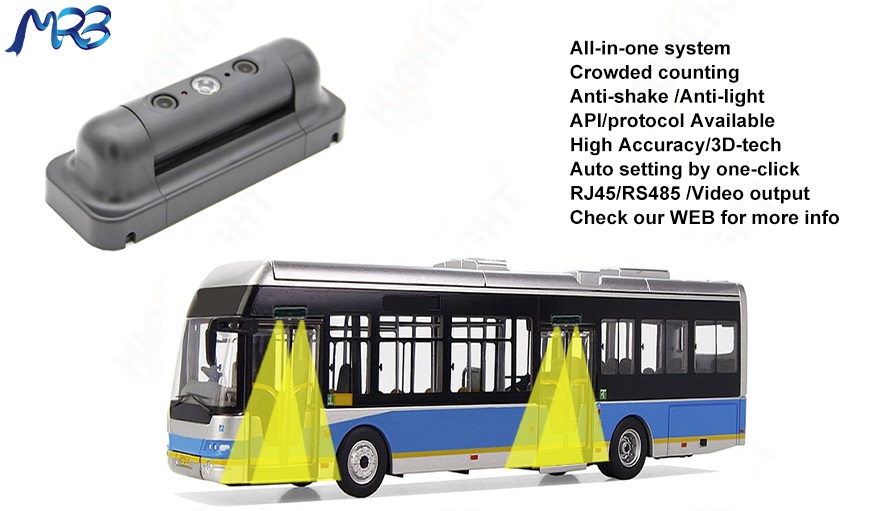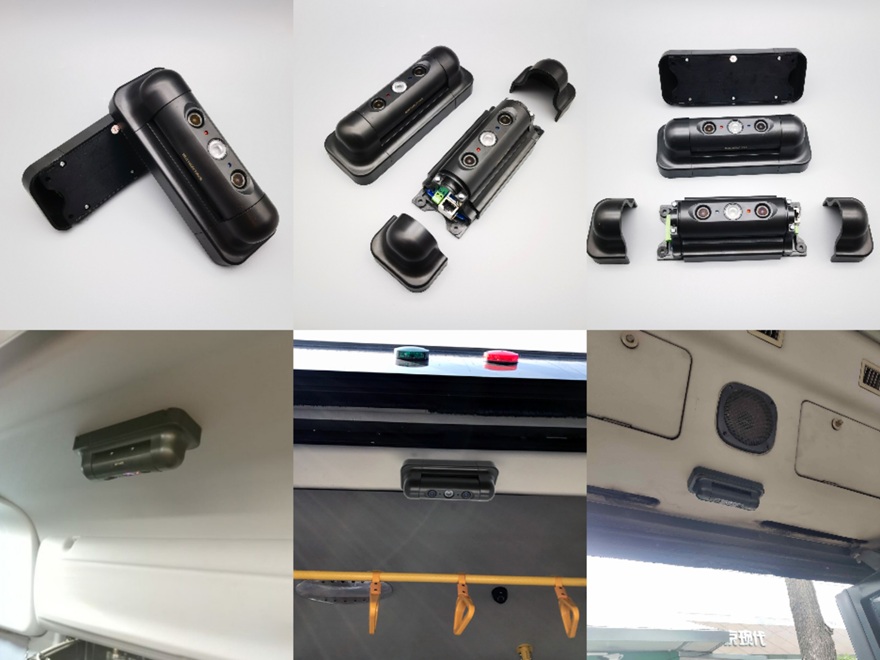Unlock the Potential of Your Smart Bus Project with MRB's HPC168 Automatic Passenger Counter
In the realm of smart bus projects, the automatic passenger counter for bus has emerged as an indispensable component, playing a pivotal role in revolutionizing the efficiency and effectiveness of public transportation. By accurately tracking the number of passengers boarding and alighting from buses, these advanced devices provide a wealth of data that is instrumental in optimizing various aspects of bus operations. Among the plethora of automatic passenger counters available in the market, the HPC168 passenger counting system by MRB stands out as a remarkable solution, offering a comprehensive set of features and benefits that make it an ideal choice for smart bus projects.
Table of Contents
1. High-Precision Passenger Counting: The Foundation of Smart Bus Operations
2. Robust Durability for Harsh Bus Environments
3. Easy Integration with Existing Smart Bus Systems
4. Cost-Effective Solution for Long-Term Investment
1. High-Precision Passenger Counting: The Foundation of Smart Bus Operations
Accurate passenger counting is the cornerstone of efficient smart bus operations, and the HPC168 automated passenger counting system for bus from MRB excels in this aspect.
The HPC168 automated passenger counter is equipped with state-of-the-art sensor technology. It employs advanced infrared sensors and high-definition cameras, which work in tandem to provide highly accurate passenger counting. When passengers board or alight from the bus, the passenger counter sensors can precisely detect their movement, even in complex situations. For example, in low-light conditions during early mornings or late evenings, the infrared sensors of the HPC168 passenger counting system can still accurately identify passengers without being affected by the darkness. This is a significant advantage over traditional passenger counting methods that may be hampered by insufficient lighting.
Moreover, in crowded scenarios, such as during rush hours when buses are filled to capacity, the HPC168 passenger counting sensor with camera remains unfazed. Its sophisticated algorithm can distinguish between individual passengers, preventing double-counting or missed counts. This high-precision counting ability ensures that the data collected is reliable. For smart bus operators, this accurate data is invaluable. It serves as the basis for various crucial decisions, such as determining the most popular routes, peak travel times, and the number of buses required to meet demand. By relying on the precise passenger count data provided by the HPC168 bus people counter, bus companies can optimize their resources, reduce operational costs, and improve overall service quality, making it an essential component for any smart bus project.
2. Robust Durability for Harsh Bus Environments
Buses operate in demanding environments, and the durability of the passenger counter is of utmost importance. The HPC168 automatic bus passenger counting camera from MRB is engineered to withstand the rigors of the bus interior.
The HPC168 people counter for bus features a rugged and durable housing. Constructed from high-quality materials, it can resist impacts and vibrations that are common during bus operations. Whether the bus is traversing bumpy roads or making sudden stops and starts, the HPC168 3D passenger counting camera's sturdy housing ensures that the internal components remain intact. This is in contrast to some less-durable passenger counters that may experience damage to their casings, leading to malfunctions or reduced lifespan.
Moreover, the internal electronic components of the HPC168 bus passenger counting system have been specially treated. They are designed to operate stably in high-temperature conditions, such as those encountered during hot summer days when the bus interior can heat up significantly. Additionally, the HPC168 passenger counter device can handle high humidity levels, which are common in various weather conditions. This resistance to extreme environmental factors means that the HPC168 automatic passenger counter has a lower failure rate compared to other models. Reducing the frequency of malfunctions not only ensures the continuous and accurate collection of passenger data but also cuts down on maintenance costs for bus operators. They don't have to worry about frequently replacing or repairing the passenger counter sensor, saving both time and money in the long run.
3. Easy Integration with Existing Smart Bus Systems
Integrating new technologies into existing systems can often be a complex and time-consuming process. However, the HPC168 automated passenger counter system by MRB simplifies this task in smart bus projects.
The HPC168 3D camera passenger counting system for bus is designed with standard interfaces and communication protocols. It comes equipped with interfaces such as RS-485 and Ethernet, which are widely used in the field of transportation technology. These standard interfaces enable seamless integration with the existing monitoring and dispatching systems of buses. For example, it can be easily connected to the on-board CCTV monitoring system. By integrating with the CCTV system, the passenger counting data from the HPC168 passenger counter device can be correlated with the video footage. This allows bus operators to visually verify the passenger count in case of any discrepancies, enhancing the accuracy and reliability of the data.
Moreover, the HPC168 electronic passenger counting camera can be smoothly integrated with the bus dispatching system. Once integrated, the real-time passenger count data can be transmitted to the dispatching center. This data provides valuable insights for dispatchers. They can adjust the bus schedules in a timely manner according to the passenger flow. If a particular route shows a sudden increase in passenger numbers, the dispatcher can send additional buses or adjust the intervals between buses to meet the demand. This seamless integration not only improves the efficiency of data transmission but also enables centralized management of bus operations. It streamlines the overall workflow, reduces the need for manual data entry and processing, and ultimately contributes to more efficient and effective smart bus operations.
4. Cost-Effective Solution for Long-Term Investment
For smart bus projects, cost-effectiveness is a crucial factor, and the HPC168 automatic passenger head counter by MRB offers an outstanding solution in this regard.
The initial investment in the HPC168 smart bus passenger counting system is reasonable, especially considering its advanced features and capabilities. It provides bus operators with a cost-efficient way to enhance their operations without a hefty upfront cost. This is a significant advantage, as many bus companies may be hesitant to invest large sums in new technologies. The HPC168 bus passenger counter device allows them to access high-quality automatic passenger counting technology at an affordable price point.
In the long run, the HPC168 automatic bus passenger counter sensor can effectively reduce operational costs. Traditionally, bus companies may rely on manual passenger counting methods, which require a significant amount of manpower. By using the HPC168 automatic passenger counting system for public transport, these labor-intensive tasks can be automated, leading to a substantial reduction in labor costs. For example, fewer employees are needed to count passengers manually, and the time saved can be allocated to other important tasks within the bus operation.
Moreover, the accurate data provided by the HPC168 automatic passenger counter enables better-informed decision-making. With precise information on passenger flow, bus companies can optimize their routes. They can identify under-utilized routes and re-allocate resources to areas with higher demand. This optimization can lead to a more efficient use of buses, reducing fuel consumption and maintenance costs associated with running unnecessary routes. In addition, it can enhance the overall service quality, attracting more passengers and potentially increasing revenue. Overall, the HPC168 real-time bus passenger counting system proves to be a cost-effective solution that offers long-term value for smart bus projects.
In conclusion, the HPC168 automatic passenger counter by MRB offers a multitude of benefits that are essential for smart bus projects. Its high-precision passenger counting ensures reliable data collection, which is the foundation for optimizing bus operations. The robust durability of the HPC168 bus people counter allows it to function flawlessly in the harsh bus environment, reducing the risk of malfunctions and minimizing maintenance costs. The easy integration with existing smart bus systems streamlines the data-sharing process and enables more efficient centralized management. Moreover, its cost-effectiveness makes it an attractive long-term investment, as it not only has a reasonable initial price but also helps in cutting down operational costs in the long run.
If you are involved in smart bus projects and aiming to enhance the intelligence and efficiency of your bus operations, the HPC168 automated people counter for bus is a product well worth considering. By adopting the HPC168 3D passenger counting camera for bus, you can take a significant step forward in revolutionizing your smart bus services, providing better-quality transportation for passengers while also improving the overall economic viability of your bus operations.

Author: Lily Updated: October 23th, 2025
Lily is a Senior Solutions Specialist in Smart Urban Mobility at MRB, with over 10 years of experience helping transit agencies and city governments design and implement data-driven public transportation systems. She specializes in bridging the gap between technology and real-world transit needs—from optimizing passenger flow to integrating smart devices like the HPC168 passenger counter into existing operations. Lily has worked on projects around the world, and her insights are rooted in hands-on collaboration with transit operators, ensuring that MRB’s solutions not only meet technical standards but also solve the everyday challenges of public transit. When she’s not working, Lily enjoys exploring city bus routes in her free time, testing out how smart technology improves the passenger experience firsthand.
Post time: Oct-23-2025


